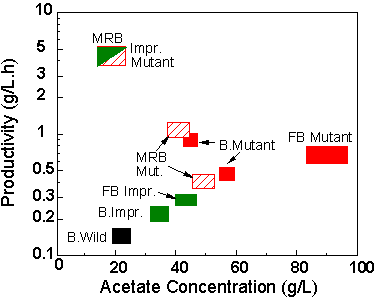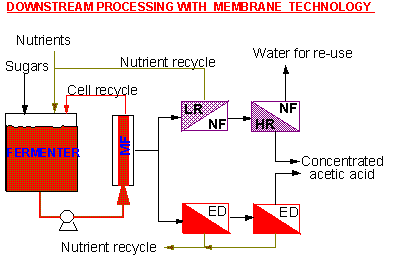|
Acetic acid, the principal constituent in vinegar, is one of the oldest fermentation products manufactured industrially. Today, the world wide acetic acid market for chemical uses exceeds 2 million tons annually. Almost all non-food industrial acetate is produced from petroleum sources. The University of Illinois at Urbana-Champaign (UIUC) began an integrated, multi-disciplinary systems approach in 1989, involving industrial microbiology, genetic improvement and biochemical engineering, to develop a biomass-based process for the manufacture of acetic acid and its derivatives by fermentation. Our research program focused on corn as the preferred biomass source. This is because there already exists a relatively sophisticated corn refining industry located near major markets for acetic acid and acetate derivatives such as CMA. More important, corn refiners have the technical knowledge, experience and financial resources to adopt acetate manufacturing technology. Many already have experience with fermentations and downstream processing, which are critical to the success of the biomass-to-acetate process. On the other hand, "wastes" such as cheese whey, food industry by-products, pulp and paper effluents, municipal sewage, etc., have to be collected, separated, purified and concentrated before they can be used, and then converted into readily fermentable sugars. In addition, a waste-based process may not have a corn refiner's flexibility of producing a multitude of co-products that help to balance out market fluctuations of an individual product. Thus, for now at least, the quickest way to commercialize a fermentation-based acetate process is to use dextrose (glucose) as the substrate. The cheapest source of dextrose today is corn. Calcium-Magnesium Acetate (CMA) was our first commercial acetate product investigated. This "nicer de-icer" (a name given to it by an 8th grade student for a science fair project) has been recognized as an environmentally safe alternative to chloride salts for de-icing roads. It can be produced by reacting acetic acid with dolime (high-magnesium lime). At present, CMA is produced from petroleum-derived acetic acid at a market price of about $700 per ton. The cost of CMA could be reduced if acetic acid is produced (via fermentation) from cheaper raw materials (e.g., biomass). We focused on the direct anaerobic fermentation route rather than the indirect aerobic (vinegar) process due to its higher yields and potentially lower costs. Phase I of our project involved selecting and improving appropriate strains of microorganisms to raise the level of acetate in the fermentation broth to a more economical level. Through adaptation, selection and mutation, a robust strain of Clostridium thermoaceticum was developed with good tolerance to acetate and sturdy enough to withstand repeated handling and continuous operation in high-rate bioreactors. This strain has been deposited with ATCC and with DSM, so that industry and other researchers can expedite commercialization. Independent laboratories have confirmed that the calcium:magnesium ratio of the UI corn-based CMA (called U-OFF-ICE) is similar to the petroleum derived product. Other tests show that U-OFF-ICE has good ice-melting properties. With a view to rapidly commercializing this process, the following goals were set for Phase II of the R&D program, which began in 1992:
All targets for Phase II were successfully achieved. As shown in the diagram above, the productivity of the fermentation and the product concentration were increased by a combination of microbiology (mutation/selection), and biochemical engineering (bioreactor design). From a 2% acetate concentration with the wild strain in a batch fermenter (designated "B" in the figure), we improved the strain (designated "Impr.") and achieved 10% CMA concentration with a mutant strain in a fed-batch ("FB") fermenter. Very high productivities have been obtained with continuous membrane recycle bioreactors ("MRB"). The membrane bioreactor has been operated for up to 54 days continuously with good stability and steady outputs. Several acetate salts (sodium, potassium, ammonium, calcium-magnesium/CMA) have been produced. Alternate low-cost nutrients for this fermentation were then screened and the organism adapted appropriately. Since these alternate nutrients are corn-based and/or soy-based, it will further enhance the value of the co-products from these industries while lowering the cost of production of acetate. Downstream processing has focused on membrane technology for the purification and concentration steps. As shown in the diagram below, the primary cell separation and recycle step is done with ceramic microfiltration (MF) membranes. The cell free broth is then processed by nanofiltration (NF) to isolate and preconcentrate the acetate. Electrodialysis (ED) is another membrane technology that can produce a 30% product stream. This should obviate the need for about half the evaporation capacity. Most important, both these membrane technologies allow for recycle of the nutrients. Phase III of the research program began in 1996 and was completed in 1998. We developed methods for conversion of acetate salts in the fermentation broth into the acid form and its subsequent purification to industrial grade acetic acid. This was accomplished with techniques such as bipolar electrodialysis, liquid-liquid extraction, vacuum distillation and esterification. The manufacture of higher-value products such as ethyl and butyl acetates was also investigated. Uses of CMA and other acetates
Updated January 2006 by mcheryan@uiuc.edu |


